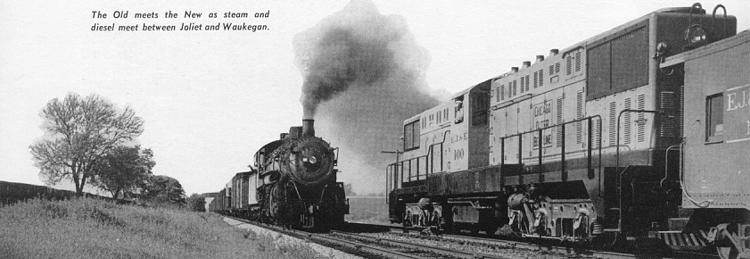|
Porter, Ind., the road connects with every major railroad entering Chicago, thereby providing fa- cilities for road-to-road transfer at points outside the congested area of Chicago. No passenger ser- vice is operated. Cars are set out and picked up at the many interchange points along the line, and at some of these connections considerable switching work is performed. The volume of traf- fic is such, that on the basis of cars handled per mile of track, it is considered the second busiest line in the country. The traffic is composed of va- rious commodities, but those products essential to the manufacture of steel predominate. In view of this type of lading, its volume, and the need for speedy delivery, it can readily be seen that a heavy task is imposed upon the mo- tive power. This new 360,000-lb Baldwin diesel- electric locomotive, carrying road number 100, on its first run between Joliet and Waukegan, easily hauled the heaviest train in the road's history over the 74 intervening miles of track. The locomotive has a centrally located operat- ing cab between the two engine hoods. Each hood contains one Baldwin eight cylinder-in-line diesel engine which develops its rated 1,000 hp at 625 rpm. Two Westinghouse type 480-C, d-c interpole, self-ventilated, and separately excited main generators are used. They furnish current to the six axle-hung traction motors. Westing- house type 370-F, which are connected to each of the six axles with single-reduction gearing. The traction motors are force ventilated by two motor- driven blowers. The basic characteristics of the diesel engines, which are known as type 608NA, are similar to these previously used in the most recent Baldwin |
switching locomotive. In accordance with usual Baldwin practice, there is included integral mount- ing for the diesel engine and generator and im- proved four-valve cylinder heads arranged for direct injection. Chromium plated cylinder liners are used. The cab location provides excellent visi- bility in either direction and is equipped with dual control stands so as to eliminate the neces- sity of turning the locomotive at the end of the run. One of the outstanding features of this locomo- tive is the use of new design three-axle trucks which are equipped with three motors each, mak- ing a total of six traction motors on the locomo- tive. This increased motor capacity provides the exceptionally high continuous rating tractive ef- fort of 64,200 Ib at 9.4 mph. Individual motors for driving traction motor blowers and radiator fans are incorporated together with thermostatically controlled radiator shutters and automatic speed control for radiator fans. A very effective slip con- trol arrangement providing for instantaneous re- duction of diesel engine power output when slip- ping occurs together with an audible signal for the operator are also embodied in this unit. The general characteristics of this locomotive are as follows: Wheel Arrangement ............................0-6-6-0 Diesel Engines, Two 8 Cylinders in Line, Four-Cycle, Normally Aspirated, 1,000- hp, each. Total for Traction ..............2,000 hp Driving Motors—Number .............................6 Maximum Speed Restriction ..............65 mph Gear Ratio ...........................................15:63 Wheels—Driving ..................................6 Pairs Diameter .................................................42" |
